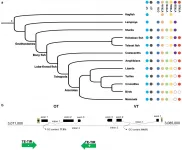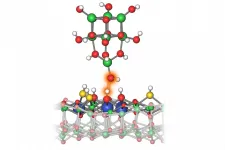(Press-News.org) Enhancing the brain's lymphatic system when administering immunotherapies may lead to better clinical outcomes for Alzheimer's disease patients, according to a new study in mice. Results published April 28 in Nature suggest that treatments such as the immunotherapies BAN2401 or aducanumab might be more effective when the brain's lymphatic system can better drain the amyloid-beta protein that accumulates in the brains of those living with Alzheimer's. Major funding for the research was provided by the National Institute on Aging (NIA), part of the National Institutes of Health, and all study data is now freely available to the broader scientific community.
"A broad range of research on immunotherapies in development to treat Alzheimer's by targeting amyloid-beta has not to date demonstrated consistent results," said NIA Director Richard J. Hodes, M.D. "While this study's findings require further confirmation, the link it has identified between a well-functioning lymphatic system in the brain and the ability to reduce amyloid-beta accumulation may be a significant step forward in pursuing this class of therapeutics."
Abnormal buildup of amyloid-beta is one hallmark of Alzheimer's disease. The brain's lymphatic drainage system, which removes cellular debris and other waste, plays an important part in that accumulation. A 2018 NIA-supported study showed a link between impaired lymphatic vessels and increased amyloid-beta deposits in the brains of aging mice, suggesting these vessels could play a role in age-related cognitive decline and Alzheimer's. The lymphatic system is made up of vessels which run alongside blood vessels and which carry immune cells and waste to lymph nodes. Lymphatic vessels extend into the brain's meninges, which are membranes that surround the brain and spinal cord.
For this new study, the research team sought to determine whether changing how well the lymphatic drainage works in the brain could affect the levels of amyloid-beta and the success of antibody treatments that target amyloid-beta. Using a mouse model of early-onset Alzheimer's, researchers removed some of the lymphatic vessels in the brains of one group of mice. They treated these mice, as well as a control group, with injections of monoclonal antibody therapies, including a mouse version of aducanumab.
Mice with less functional lymphatic systems had greater buildup of amyloid-beta plaques and of other immune cells that cause inflammation, which is another factor in Alzheimer's pathology. Moreover, when the researchers compared immune cells in the brains of human Alzheimer's patients with those of the mice whose meningeal lymphatic system had been diminished, they found that the genetic fingerprints of certain immune cells in the brain, the microglia, were very similar between people with the disease and mice with defective lymphatic vessels. These mice also performed more poorly on a test of learning and memory performance, suggesting that dysfunctional lymphatic drainage in the brain contributes to cognitive impairment and increases difficulties for antibodies that target amyloid-beta.
The researchers also assessed whether boosting the brain's lymphatic system could reverse these changes. They injected mice with amyloid-beta antibody therapies along with a growth factor that enhances the function of the brain's meningeal lymph vessels. The treated mice showed not only lower accumulations of amyloid-beta, but also expansion of some parts of the lymphatic system in the brain's meninges.
"These findings suggest that supporting the meningeal lymphatic system in people with Alzheimer's -- and starting treatment early in the disease, when this system is more intact -- could lead to better outcomes," said Molly V. Wagster, Ph.D., chief of the Behavioral & Systems Neuroscience Branch in NIA's Division of Neuroscience.
The research also shows that if lymphatics are removed, the mouse microglia -- "trash collector cells" in the brain -- are much closer to those in humans and that the genes upregulated in microglia upon lymphatic dysfunction are linked to different aspects of Alzheimer's pathology. Writing for the research team, Jonathan Kipnis, Ph.D., at Washington University School of Medicine in St. Louis, notes in the paper that these data demonstrate that it may be possible to devise strategies to therapeutically target microglia and the brain blood vasculature, which are both important in Alzheimer's pathophysiology, by modulating meningeal lymphatic vasculature.
The researchers suggest that future studies may help identify how well the brain's lymphatic system is working as we age. That could result in targeted treatments that could improve how well the lymphatic system drains amyloid-beta and other compounds, in turn slowing the progression of Alzheimer's.
INFORMATION:
This was funded in part by NIH grants R37AG034113, RF1AG057496, RF1AG053303, RF1AG058501, R01AG057777, R56AG067764, R01AG062734, P30AG066444, P01AG026276, and P01AG03991. It relates to NIH's AD+ADRD Research Implementation Milestone 2.B, "Establish new research programs that employ data-driven, systems-based approaches to understand the interaction between peripheral systems (in particular: immune, metabolic, microbiome) and the brain and the impact of this interaction on brain aging and neurodegeneration."
Reference: Da Mesquita et al. Meningeal lymphatics modify Alzheimer's disease and immunotherapy. Nature. 2021 Apr 28 doi: 10.1038/s41586-021-03489-0
About the National Institute on Aging (NIA): NIA leads the U.S. federal government effort to conduct and support research on aging and the health and well-being of older people. Learn more about age-related cognitive change and neurodegenerative diseases via NIA's Alzheimer's and related Dementias Education and Referral (ADEAR) Center website. Visit the main NIA website for information about a range of aging topics, in English and Spanish, and stay connected.
About the National Institutes of Health (NIH): NIH, the nation's medical research agency, includes 27 Institutes and Centers and is a component of the U.S. Department of Health and Human Services. NIH is the primary federal agency conducting and supporting basic, clinical, and translational medical research, and is investigating the causes, treatments, and cures for both common and rare diseases. For more information about NIH and its programs, visit http://www.nih.gov.
NIH...Turning Discovery Into Health®
For the first time, scientists are able to study changes in the DNA of any human tissue, following the resolution of long-standing technical challenges by scientists at the Wellcome Sanger Institute. The new method, called nanorate sequencing (NanoSeq), makes it possible to study how genetic changes occur in human tissues with unprecedented accuracy.
The study, published today (28 April) in Nature, represents a major advance for research into cancer and ageing. Using NanoSeq to study samples of blood, colon, brain and muscle, the research also challenges the idea that cell division is the main mechanism ...
Models that can successfully predict suicides in a general population sample can perform poorly in some racial or ethnic groups, according to a study by Kaiser Permanente researchers published April 28 in JAMA Psychiatry.
The new findings show that 2 suicide prediction models are less accurate for Black, American Indian, and Alaska Native people and demonstrate how all prediction models should be evaluated before they are used. The study is believed to be the first to look at how the latest statistical methods to assess suicide risk perform when tested specifically in different ethnic and racial groups.
More ...
WASHINGTON, D.C., (April 28, 2021) - The latest, comprehensive data from The North American COVID-19 Myocardial Infarction (NACMI) Registry was presented today as late-breaking clinical research at the Society for Cardiovascular Angiography & Interventions (SCAI) 2021 Scientific Sessions. Results reveal in these series of STEMI activations during the COVID era, patients who tested positive for COVID-19 were less likely to receive diagnostic angiograms. Those with COVID-19 positive status had higher in-hospital mortality. The prospective, ongoing observational registry was created under the guidance of the SCAI, Canadian Association of Interventional Cardiology (CAIC) and American College of Cardiology (ACC). ...
WASHINGTON, D.C., (April 28, 2021) - Two new studies, presented today as late-breaking clinical science at the Society for Cardiovascular Angiography & Interventions (SCAI) 2021 Scientific Sessions, provide new treatment insights for cardiogenic shock (CS) patients. A study of the SCAI cardiogenic shock stages consensus document confirms the accuracy of the shock classification. In addition, an analysis of the National Cardiogenic Shock Initiative demonstrates use of a shock protocol emphasizing early use of mechanical circulatory support may lead to improved survival for patients with CS.
CS is a rare, life-threatening ...
WASHINGTON, D.C, (April 28, 2021) - An analysis of the prospective Fuwai PCI Registry, confirms long-term dual antiplatelet therapy (DAPT) is an optimal treatment option for acute coronary syndrome patients (ACS) following a percutaneous coronary intervention (PCI). The study shows long-term DAPT reduces ischemic events without increasing bleeding or other complications as compared to short-term DAPT treatments. The study was presented today as late-breaking clinical research at the Society for Cardiovascular Angiography &Interventions (SCAI) 2021 Scientific Sessions.
Following ACS, patients have a high risk of ischemic events, which impacts chances of survival. Patients are predisposed for blood clots ...
Chinese scientists have made direct observations in face-centered cubic VCoNi (medium)-entropy alloys (MEA) and for the first time proposed a convincing identification of subnanoscale chemical short-range order (CSRO). This achievement undisputedly resolves the pressing question of if, what and why CSRO exists, and how to explicitly identify CSRO.
This work, published in Nature on April 29, was conducted by Prof. WU Xiaolei from the Institute of Mechanics of the Chinese Academy of Sciences (CAS) in collaboration with Prof. MA En's team from Xi'an Jiaotong University and Prof. ZHU Jing's team from Tsinghua University.
Multi-principal element alloys--also known as high (medium)-entropy alloys (HEAs/MEAs)--are a hot and frontier topic in multidisciplinary fields. In these ...
Oxytocin and arginine vasopressin are two hormones in the endocrine system that can act as neurotransmitters and regulate -in vertebrates and invertebrates- a wide range of biological functions, such as bonding formation, breastfeeding, birth or arterial pressure. Biochemists in the pregenomic era, named these genes differently in different species, due to small protein coding differences.
A new study carried out by the University of Barcelona (UB) and the Rockefeller University, published in the journal Nature, has analysed and compared the genome of 35 species representing ...
Researchers have discovered an explanation for why cerebral cavernous malformations (CCMs)--clusters of dilated blood vessels in the brain--can suddenly grow to cause seizures or stroke. Specifically, they found that a specific, acquired mutation in a cancer-causing gene (PIK3CA) could exacerbate existing CCMs in the brain. Furthermore, repurposing an already existing anticancer drug showed promise in mouse models of CCMs in improving brain-vascular health and preventing bleeding into the brain tissue.
Previous studies linked the initial formation of CCMs to various environmental factors, including ...
The degree of acidity or alkalinity of a substance is crucial for its chemical behavior. The decisive factor is the so-called proton affinity, which indicates how easily an entity accepts or releases a single proton. While it is easy to measure this for molecules, it has not been possible for surfaces. This is important because atoms on surfaces have very different proton affinities, depending on where they sit.
Researchers at TU Wien have now succeeded in making this important physical quantity experimentally accessible for the first time: Using a specially modified atomic force microscope, it is possible to study the proton affinity of individual atoms. This should help to analyze catalysts on an atomic scale. The results have been published in the scientific journal Nature.
Precision ...
COLUMBUS, Ohio - Tiny molecules called nanobodies, which can be designed to mimic antibody structures and functions, may be the key to blocking a tick-borne bacterial infection that remains out of reach of almost all antibiotics, new research suggests.
The infection is called human monocytic ehrlichiosis, and is one of the most prevalent and potentially life-threatening tick-borne diseases in the United States. The disease initially causes flu-like symptoms common to many illnesses, and in rare cases can be fatal if left untreated.
Most antibiotics can't build up ...


